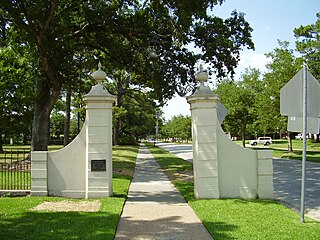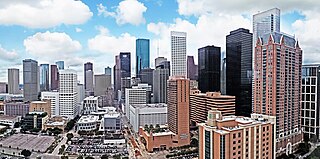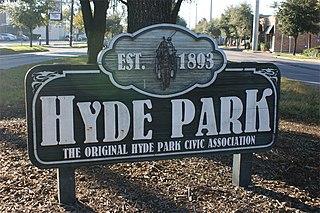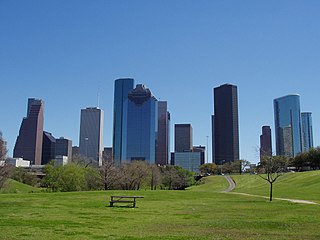
River Oaks is a residential community located in the center of Houston, Texas, United States. Located within the 610 Loop and between Downtown and Uptown, the community spans 1,100 acres (450 ha). Established in the 1920s by brothers Will Hogg and Michael Hogg, the community became a well-publicized national model for community planning. Real estate values in the community range from $1 million to over $20 million. River Oaks was also named the most expensive neighborhood in Houston in 2013. The community is home to River Oaks Country Club, which includes a golf course designed by architect Donald Ross and redesigned in 2015 by Tom Fazio.

Montrose is an area located in west-central Houston, Texas, United States and is one of the city's major cultural areas. Montrose is a 7.5 square miles (19 km2) area roughly bounded by Interstate 69/U.S. Highway 59 to the south, Allen Parkway to the north, South Shepherd Drive to the west, and Taft to Fairview to Bagby to Highway 59 to Main to the east. Montrose neighborhoods include Cherryhurst, Courtlandt Place, Hyde Park, Montrose, Vermont Commons, North and East Montrose, Mandell Place and Winlow Place. Montrose is also less well known by the moniker Neartown, encompassing Superneighborhood #24.
Timeline of historical events of Houston, Texas, United States:

The geographic areas of Houston are generally classified as either being inside or outside Interstate 610, colloquially called "the Loop". The Loop generally encircles the central business district and the "island cities" of West University Place, Southside Place, and a portion of Bellaire.

The Bayou City Art Festival is an arts festival held biannually by the Art Colony Association in Houston, Texas. The festival is held in Memorial Park in the spring and in Downtown Houston in the fall.

Montrose is a neighborhood located in west-central Houston, Texas, United States. Montrose is a 7.5-square-mile (19 km2) area roughly bounded by Interstate 69/U.S. Highway 59 to the south, Allen Parkway to the north, South Shepherd Drive to the west, and Taft to Fairview to Bagby to Highway 59 to Main to the east. The area is also referred to as Neartown or Neartown / Montrose.
Briargrove Park (BGP) is a subdivision in western Houston, Texas, United States. It has about 1,480 houses. It is bounded by Beltway 8, the Buffalo Bayou, Gessner Road, and Westheimer Road.

Westheimer Road is an arterial east–west road in Houston, Texas, United States. It runs from Bagby Street in Downtown and terminates at the Westpark Tollway on the southern edge of George Bush Park, stretching about 19 miles (31 km) long. The street was named after Michael Louis Westheimer, a German immigrant and flour salesman.

The Houston Gay Pride Parade is the major feature of a gay pride festival held annually since 1979. The festival takes place in June to celebrate the lesbian, gay, bisexual, and transgender people and their allies. This event commemorates the 1969 police raid of the Stonewall Inn on Christopher Street in New York City's Greenwich Village neighborhood, which is generally considered to be the beginning of the modern gay rights movement.

Annunciation Greek Orthodox Cathedral is the spiritual home of the largest Eastern Orthodox parish in Houston, Texas. It is located in Montrose and Neartown.
The Houston Alternative Art chronology was originally compiled by Caroline Huber and The Art Guys for the exhibition catalogue No Zoning: Artists Engage Houston, which was published by the Contemporary Arts Museum Houston (CAMH) to accompany the group show of the same name. The exhibition was on view at CAMH from May 9-October 4, 2009. No Zoning: Artists Engage Houston was co-curated by Toby Kamps and Meredith Goldsmith and featured projects by twenty-one Houston artists using the city as inspiration, material, and site. This chronology documents Houston's alternative art scene.

The Westmoreland Historic District is a neighborhood in Neartown Houston, Texas. It is west of Spur 527, between Westheimer Road and West Alabama Street.

Atlanta's mild climate and plentiful trees allow for festivals and events to take place in the city year-round. One of the city's most popular events is the Atlanta Dogwood Festival, an arts and crafts festival held in Piedmont Park each spring, when the native dogwoods are in bloom. Atlanta Streets Alive, inspired by the ciclovía in Bogotá, Colombia, closes city streets to car traffic to allow people to participate in health and community-oriented, such as bicycling, strolling, skating, people-watching, tango, yoga, hula hooping, and break dancing.

Free Press Houston was a free monthly newsprint publication focusing on arts, entertainment, culture and politics. Founded in March 2003 by Omar and Andrea Afra, Free Press Houston was distributed throughout the greater Houston area with particularly strong distribution in inner city neighborhoods such as Montrose, Heights, and the Houston Warehouse District.

Hyde Park is a historic community located in the Montrose neighborhood of Houston, Texas. Its southeast boundary is the intersection Montrose Boulevard and Westheimer. The neighborhood was established in the late 1800s on the summer farm of the second President of the Republic of Texas, Mirabeau Lamar. In the 1970s, Hyde Park became a central part of the Gay Rights Movement in Houston. Like much of Montrose, the neighborhood is now experiencing significant gentrification, and is home to an abundance of restaurants, including Mexican, Italian, Greek, American, Lebanese, coffee houses, and numerous bars.
Meteor, also known as Meteor Houston, Meteor Nightclub, or Meteor Urban Video Lounge, was a gay bar and nightclub in Neartown, Houston, Texas, in the United States. The bar hosted an annual Mr. Gay Pride Houston competition.

Lower Westheimer is an area in Houston, Texas, United States. It is centered on Westheimer Road, and is considered to be East of Shepherd, and West of Midtown. Several historic neighborhoods are partially or completely located within the area including Montrose and Hyde Park. Lower Wertheimer is known for its hipster culture, nightlife, arts, and food scene.














